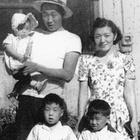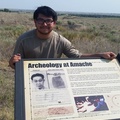These were not letters from a summer camp like the funny one from a young homesick camper as written by songwriter, Allan Sherman, in his 1964 Grammy Award winning song which began, “Hello Muddah – Hello Faddah – Here I am – in Camp Granada…” No!…Although the letters from the camp of which I speak were from Granada, they were actually from the Granada War Relocation Authority Center, a prison camp!
The WRA camp’s name was changed from Granada to Amache to avoid confusion with the post office in the nearby town of Granada, Colorado. Amache, the name of a Cheyenne Indian chief’s daughter, who in the history of the area was married to John Prowers after whom the county was named and in which the camp was located. It was from the Amache camp post office that the “letters from camp” were sent.
Amache was one of ten “concentration camps,” so-called even by President Franklin Delano Roosevelt and other prominent politicians, all hastily erected in the “badlands” of the United States of America. “Badlands,” a term used by Hearst newspapers syndicated columnist Henry McLemore who reflected and fed the fire of growing hateful public sentiment in this mean spirited statement from his column:
“I am for the immediate removal of every Japanese on the West Coast to a point deep in the interior. I don’t mean a nice part of the interior either. Herd ‘em up, pack ‘em off and give ‘em the inside room in the badlands…Personally, I hate the Japanese. And that goes for all of them.”1
It was President FDR who signed Executive Order 9066, on February 19, 1942, which authorized the unlawful forced ouster and the imprisonment of west coast America’s Japanese population into these prison camps following Japan’s aerial attack on Pearl Harbor.
Amache held over 7,000 Japanese inmates which was over ten-times the population of the town of Granada. Amache is the camp where my brother, sister, and I were imprisoned along with our parents, their parents, and their siblings arriving on September 18, 1942. We were three generations (Issei, Nisei, & Sansei), two families, the Okamura and the Ono, totaling twenty-one members, but sadly we were without Suyeichi, 55, the head of the Okamura family, our grandfather, father, and father-in-law. His not being with the family became the reason for the “letters from camp.”
Our maternal grandfather or Jichan (term we grandkids used as opposed to the formally correct, Ojiichan), was the 1906 founder of Benkyodo, a Japanese confectionary business, which is still being successfully operated by my Sansei cousins, Rick and Bob Okamura and their Nisei mother, Sue (Suyeko Kurihara). Jichan and Bachan (as opposed to Obasan), had seven children including my mother, Kimiye, the second oldest sibling. Jichan became a San Francisco Japantown community leader and active in many of its organizations, which was some of the reasons given for his arrest the day after Japan’s December 7, 1941 attack of the U.S. Territory of Hawaii.
The treacherous humiliation of being forced to leave jobs, schools, farms, and homes and to be herded into primitive Assembly Centers and then later imprisoned in equally shoddily-built camps was compounded by the early “lopping-off-the-heads” of many family households including ours. These family heads, community leaders were quickly taken prisoners as “Enemy Aliens” leaving families to fend for themselves. The swiftness and efficiency with which the teams of Federal Bureau of Investigation agents made the arrests, not only of Japanese, but German and Italian aliens as well, illustrates the fact that surveillance of these arrestees had been ongoing years before the outbreak of WWII and proof that detailed arrest plans were well-in-place.
As presented in his comprehensive book, Judgment Without Trial: Japanese American Imprisonment During WWII, Tetsuden Kashima, professor of American ethnic studies at the University of Washington, “the arrest and removal of this group from the West Coast just after December 7, 1941 and for months into 1942, then was the product of a rational and deliberate decision-making process.” Kashima’s book is an in-depth study of the Alien Enemy Control program and general internment, a must-read for families that have had their father, grandfather, or by now, great-grandfathers who were caught in this frustrating trap.
Jichan and those arrested in San Francisco were taken to 801 Silver Avenue, then an Immigration and Naturalization Service Detention facility, an architecturally beautiful complex that was built in 1928 as the Salvation Army College for Officers, but because of the 1930 Depression, by 1933 they lost it to bond holders. Eventually, following many other occupants, it was taken-over by the INS and used for the initial incarceration of the Japanese, German, and Italian Alien Enemies. Today it is the Cornerstone Evangelical Baptist Church & Academy as seen in my 2010 photograph below, the strikingly beautiful exterior is virtually unchanged after 80-plus years.
From there began what must have been an anxiety-laden journey for Jichan and the other Issei prisoners. As I grew older, I became more curious about this and other family history. From family chit-chat over the years, I heard that Jichan was shuttled through many Department of Justice and U.S. Army prison camps and later learned the names of those camps.
Note:
1. http://en.wikipedia.org/wiki/Japanese_American_internment#cite_ref-27
*All photos are the courtesy of Gary Ono
© 2011 Gary Ono








